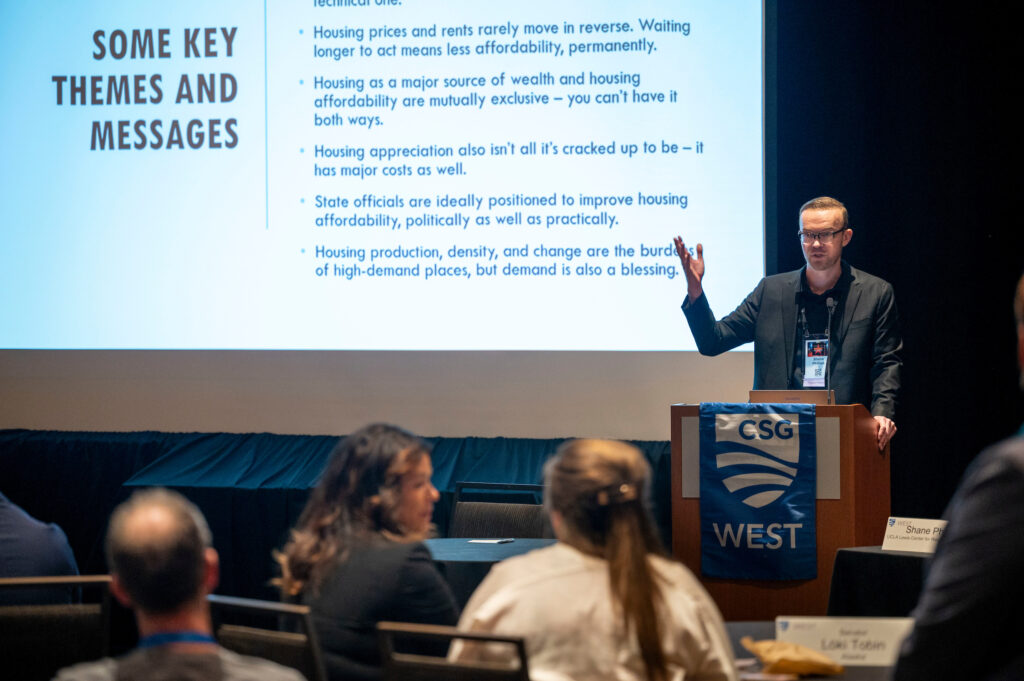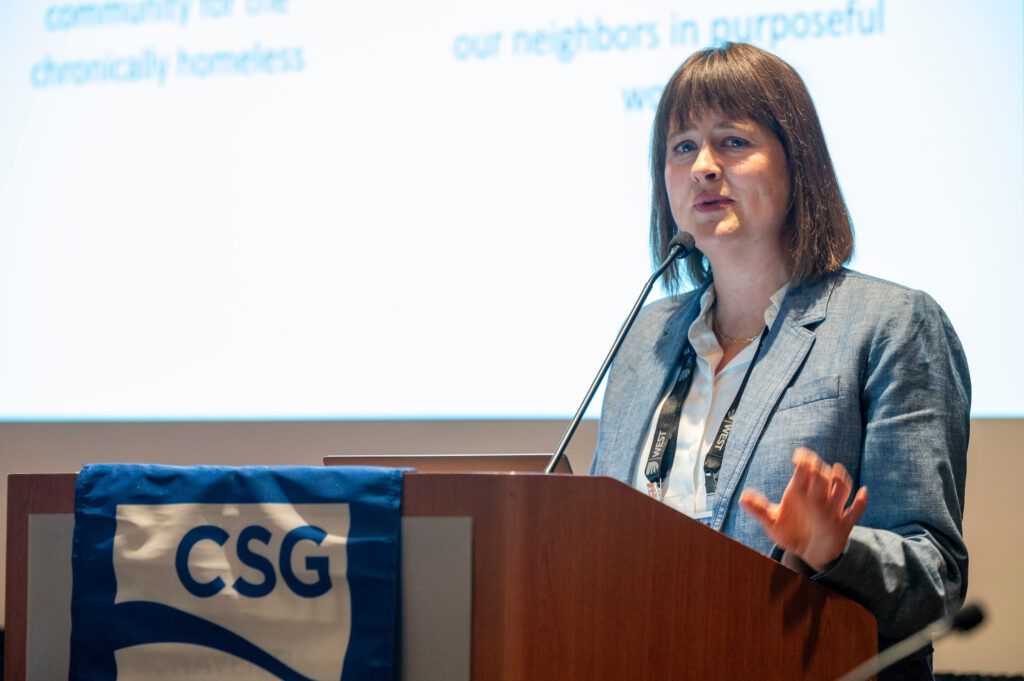
Housing Committee Recap:
Shane Phillips, Housing Initiative Project Manager with the UCLA Lewis Center for Regional Policy Studies, focused on the intricate dynamics of housing policy, with an emphasis on navigating the trade-offs between different perspectives.
In Part 2 of this session, Tracee Henneke, Director of Relationships & Giving for Mobile Loaves and Fishes, provided a comprehensive view of Community First! Village – often referred to as “Austin’s most talked about neighborhood.”

Part 1: Housing Affordability
Approaches to housing policy are nuanced
Phillips contends that housing reform involves winners and losers but emphasizes the importance of a well-balanced approach to benefit the majority. Underscoring the political nature of housing reform, he asserts that finding the right mix is essential to ensure widespread benefit. Phillips argues that delay in addressing housing challenges leads to a lasting decrease in affordability.
Tension between housing as a source of wealth and affordability
The tension between housing as a source of wealth and its affordability is a central theme. Phillips challenges the notion that housing appreciation is universally positive, shedding light on its substantial drawbacks. He introduced the pro-housing versus pro-tenant perspectives, contending that pro-housing advocate typically focuses on who benefits from development, while the pro-tenant advocate questions who is harmed. Phillips suggests that a more comprehensive approach involves asking both questions to formulate better policies and build stronger coalitions.
Saying “yes” to housing supply, stability, and subsidy
The Three S’s—Supply, Stability, and Subsidy—were presented as interconnected elements. Phillips elaborated on the importance of a growing housing stock to address scarcity and economic constraints. Stability considerations focus on moral obligations towards renters, aiming to prevent their marginalization. Subsidy policies are discussed in terms of addressing gaps left by supply and stability measures, highlighting the need for efficient use of resources.
Pick two: appealing, unchanging, or affordable
Phillips contends that every city faces a choice between being appealing, unchanging, or affordable, but can only achieve two of these traits simultaneously. If a city is appealing and unchanging, he affirms that it will lack affordability – using San Francisco as an example. If it is unchanging and affordable, such as Detroit, he suggests it may lack appeal for attracting or maintaining residents. And if a city is both appealing and affordable, Phillips argues that it won’t stay that way without new housing supply and a plan for a future with more neighbors. He cautions against denying the future, presenting examples of cities that faced consequences for attempting such an approach.
“All of the above” approaches in action:
Phillips concluded by highlighting successful approaches, including Seattle’s Housing Affordability and Livability Agenda, legislative efforts in Oregon, and “The Montana Miracle.” In these examples, he illustrated the practical implementation of comprehensive approaches in diverse contexts.
Part 2: Community First! Village | A Different Approach to Homelessness
Community First! Village has garnered attention as a 51-acre master planned development in Austin, Texas, offering affordable, permanent housing and a supportive community for those exiting chronic homelessness. A project by Mobile Loaves & Fishes, it aims to address homelessness at its core by acknowledging that “housing will never solve homelessness, but community will.” Founder Alan Graham and his wife exemplify the commitment to this vision by choosing to reside among formerly homeless neighbors.

“The Single Greatest Cause of Homelessness is a Profound, Catastrophic Loss of Family.”
– Alan Graham, Founder and CEO of Community First! Village
Homelessness arises from intersecting broken systems and layers of trauma
The village’s philosophy asserts that homelessness arises from intersecting broken systems and layers of trauma, such as loss of family, foster care, and adverse childhood experiences, among others. Residents, with an average age of 57, have most commonly been homeless for over nine years. Sixty-five percent manage two or more chronic illnesses and their average age at death is 60.
“Housing will never solve homelessness, but community will.”
At Community First! Village, the intentional design of shared spaces, including front porches and communal areas, encourages interactions among neighbors, emphasizing the importance of community building. Additionally, 20% of residents are not homeless but choose to live in community with the formerly homeless. The “Community Works” initiative is integral, empowering residents to rediscover purpose and earn a dignified income through various opportunities, such as working at the community’s gardens, art house, cinema, and Community Inn. Its micro-enterprise program enables volunteers to serve alongside formerly homeless individuals, fostering skill development and enduring relationships.
Residents, with an average age of 57, have most commonly been homeless for over nine years. Sixty-five percent manage two or more chronic illnesses and their average age at death is 60.
Partners make a difference when thinking about community impact
The village’s impact extends beyond housing. Partners include 31,550 private donors, 21 construction partners, 45 custom home builders, 100+ faith communities, and 14,820 annual volunteers. Together, their efforts have contributed to an estimated annual savings of $85 million for the Austin community when Community First! Village is at full occupancy.
Partners include 31,550 private donors, 21 construction partners, 45 custom home builders, 100+ faith communities, and 14,820 annual volunteers.
Looking forward to expanding resources
Presently, 343 formerly homeless individuals reside at Community First! Village, with a 99% rate of rent collection, and an 83% rate of housing stability. The village initiated an expansion in 2023, incorporating two new properties and 127 additional acres for 1,400 more homes. Once fully developed, Community First! Village will have 1,900 homes and neighborhood support buildings spread across 178 acres.
Resources
Book: The Affordable City: Strategies for Putting Housing Within Reach (and Keeping it There) – By Shane Phillips
Podcast: UCLA Housing Voice Podcast | Hosted by Shane Phillips
Video: Finding Home: Community First! Village
The post Housing Affordability & Homelessness in the Rapidly Growing West appeared first on CSG West.




